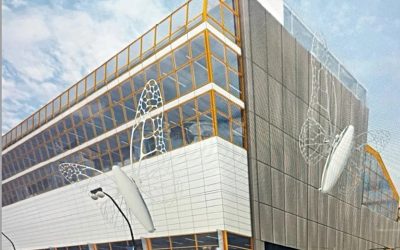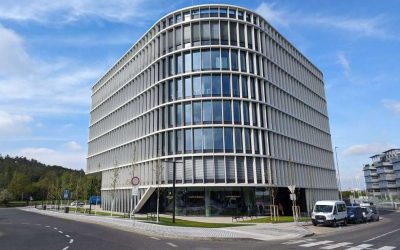A building’s reception area is in many cases the first impression of a company that potential clients and current business partners will have. Do you remember the lobbies that truly impressed you? How they looked and if they functioned well? In the same way, you probably haven’t forgotten those that did exactly the opposite. Smart systems in the reception area can enhance a positive experience, solve several problems and improve collaboration across departments.
Can your receptionist do that?
First impressions can be a stumbling block
The reception area represents your visitors’ first contact with the company. Marek Rackay told me that the truth is that even today, many reception areas don’t look very elegant and function even worse. Marek is Senior Project Manager and a colleague of mine at the Building Consultancy team at Colliers Czech Republic. “Sometimes you’re greeted by a beautifully designed interior. At the door, however, there is an unenthusiastic receptionist and a bored security guard. In such cases, the first impression is definitely not ideal.”

Marek Rackay (Colliers)
On the other hand, if you’re greeted by a smiling receptionist upon entry, and your favorite beverage is waiting for you because the property team already knows your favorite afternoon drink, you’re likely to take a very different feeling away with you. Unless, of course, you get delayed by the receptionist making you sit and wait while they dial your host to confirm your name and invitation.
“This is exactly the kind of situation we wanted to react to,” said Petr Bořuta from Spaceflow, a tenant experience applications developer that’s come out with a supplementary visitor system. In it, the visitor registers via a QR code they received from the host through a calendar invitation. “That limits the reception desk experience to picking up an entrance card,” said Bořuta. “For the host, this also means that when the visitor arrives, she receives a notification. This means there’s no need to wait for a call from the receptionist. Hence, the whole operation takes only a few seconds.”
The empty chairs phenomenon
Even when COVID-19 restrictions were eased and with a relatively high percentage of the population vaccinated, there has still been a considerable number of closed offices on the Prague market, especially multinational companies.
“Smaller companies are divided into two groups,“ Marek told me. “The first are those companies that dealt with the Covid situation minimally after their return and did not implement any major measures. The latter group, like us at Colliers, restricted access to the offices and provided a system in which employees rotate regularly.” In other cases, people are divided into groups — one group comes to the office every day and some employees work remotely.
In fact, even pre-pandemic, in companies with a thousand or more employees, as few as 40 percent of people tended to be physically present, according to Colliers’ Workspace Advisory team. The rest of the team were already working remotely or were in meetings with clients, or they were taking personal time off and so on.
“With a large number of clients, we encounter a unique post-Covid phenomenon, in which employees are returning to their offices only very slowly. It means that the occupancy of the space also increasing very slowly. As a result, managers at end users are seeking different ways to bring back employees to the offices,” added Marek.
As a result of the deployment of improved building technology, COVID-19 has shed light on the efficiency or inefficiency of office spaces. Empty desks and a change in work style are leading more companies to think not only about how much space they need, but also how best to use reception area.
From what I’ve observed, we can already see changes in how they function. Previously, three receptionists weren’t an uncommon sight. They’d be taking turns receiving visitors, booking cars, desks, meeting rooms, arranging business lunches and dealing with mail. Today, these responsibilities can be handed over to automated smart systems, where all virtually day-to-day operations can be dealt with with one simple click.
“Who did you meet yesterday?”
At Colliers, we worked with Spaceti, Spaceflow, and Sine systems. Their facility management systems or tenant experience applications can tailor their software to the needs of individual companies or landlords.
In the advisory consulting process, we use, for example, the touchONE reservation system, which allows companies (regardless of the size of the premises) to reserve all rooms using dozens of touch panels that can be connected to the main panel. This panel can be installed at the reception desk and used to manage the entire reservation system for dozens of rooms. The touchONE system even takes care of ordering coffee or sandwiches for a specific time in a specific meeting room.
“In the vast majority of cases, it’s so simple that a single tablet and a single receptionist is enough to handle all the visitors,” said Marek. “The visit is registered in a system that clearly shows which visitors are expected by whom, at what time, and where they will sit.”
Smart systems in buildings also allow managers to review data about the circulation of guests. Company leaders need to realize is that if no one has an overview of what kind of visitors are moving through their offices each day, they are losing valuable information. It’s not just a security issue. Overseeing who’s visiting the office can be key to fostering better collaboration between departments and for business development. “My colleagues at Colliers pass on information about who knows whom and who cooperates with them. This kind of information is often really helpful for colleagues and it develops effective networking,” explained Marek.
“Who did you meet with yesterday?” is a question of real importance for business development teams.
Spaceflow’s Bořuta points out that these types of data points about room usage can also help leaders make informed CAPEX decisions on crucial investments. “Our clients use anonymized booking data to understand what spaces to focus on for renovations or new buildings – how large should the meeting rooms be, and what equipment is most popular,” he said.
Also in ThePrime
3Things in Retail: Duty free down, Black Friday up, and new Covid compensation
Adamcová: Prague turns against mass tourism, targets premium visitors






